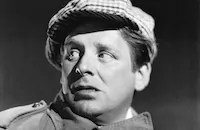Ad line for The Mysterious Mr. Wong
Bela Lugosi undertook his only Asian role in The Mysterious Mr. Wong (1935), striking terror into not just the hearts of Chinatown, but also those of fans around the world. His role as a criminal mastermind out to make himself ruler of a Chinese province by finding the twelve lost coins of Confucius also gave him a chance to show that the heavy accent he used in most of his films was just acting by this time. In the picture, Wong has an alter ego, an herb shop owner named Lychee, who speaks without the famous Lugosi accent.
The Mysterious Mr. Wong was the first of several movies he would make for Monogram studios, a poverty row company that specialized in low-budget horror and gangster films. Among his films there were such classics as The Corpse Vanishes (1942), The Ape Man (1943) and Voodoo Man (1944). Although he would end his career in poverty row quickies like these, in 1935 he was still shuttling between low-budget films and major productions. In fact, he would follow The Mysterious Mr. Wong with a trip to MGM for Mark of the Vampire (1935) for director Tod Browning, who had made him a star in the original
Dracula.
Standing between Lugosi and his dreams of conquest in The Mysterious Mr. Wong was wisecracking reporter Jason Barton (Wallace Ford) and his girlfriend Peg (Arline Judge), both of whom were stalwarts of 1930s Hollywood. Ford would appear the same year as the IRA man turned in by Victor McLaglen in John Ford's classic The Informer. He appeared in twelve other John Ford films, including The Whole Town's Talking (also 1935) and The Last Hurrah (1958). He also appeared in Tod Browning's Freaks (1932) and finished his career as Shelley Winters' hard-drinking father in A Patch of Blue (1965). In a macabre turn worthy of The Mysterious Mr. Wong, Ford, who was born Samuel Jones, took his professional name from a friend who was killed in a railroad accident while the two were bumming their way across the U.S.
Judge was more famous for her eight marriages than her many low-budget films. She had been a dancer in Jimmy Durante's nightclub act when she was discovered by Hollywood director Wesley Ruggles, who helped her get started in the movies and became her first husband. Although she appeared in occasional "A" films like Pigskin Parade (1936), which marked Judy Garland's feature-film debut, and One in a Million (1936), which brought Sonja Henie screen stardom, she spent most of her career on the wrong side of the Hollywood tracks. Appropriately, she made her last screen appearance in The Crawling Hand (1963), a film more famous for its pre-Gilligan's Island appearance by "Skipper" Alan Hale, Jr., and its repeated exposure as one of the funniest episodes of Mystery Science Theatre 3000.
Producer: George Yohalem
Director: William Nigh
Screenplay: Nina Howatt
Based on The Twelve Coins of Confucius by Harry Stephen Keeler
Cinematography: Harry Neumann
Art Direction: E.R. Hickson
Music: Abe Meyer
Cast: Bela Lugosi (Mr. Wong), Wallace Ford (Jason Barton), Arline Judge (Peg), Fred Warren (Tsung), Lotus Long (Moonflower), Robert Emmett O'Connor (McGillicuddy).
BW-63m.
by Frank Miller



















